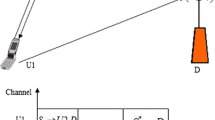Abstract
In this paper, we investigate throughput and delay enhancement for two multi-user multiple-input multiple-output (MIMO) systems one with space-time block coding (STBC), the other with spatial multiplexing (SM) at the transmitter. Users operate using the slotted ALOHA (SA) protocol to access the wireless channel resulting in a high probability of collision. For both systems, we consider the uplink scenario, and we propose to recover the collided packets with spatial successive interference cancelation (SSIC) and a protocol for retransmission and combining of unsuccessfully received collided packets applying a truncated Hybrid Automatic Repeat reQuest (HARQ) scheme. For the first system, we propose to use channel realizations of collided packets as different signatures to separate them. Moreover, we propose a solution for the problem when the received powers are comparable. For this system, we note that the orthogonality of the STBC matrix allows the use of a simple linear processing step for the initialization of SSIC. For the SM multi-user system, the separation of collided packets is based on V-BLAST processing and SSIC. We also propose how to combine retransmitted packets. For both systems, we evaluate the block error rate, the throughput, and the delay. A comparison is done with the single-user case and with other receivers proposed in the literature.













Similar content being viewed by others
References
Tsatsansis MK, Zhang R, Banerjee S (2000) Network assisted diversity for random access wireless networks. IEEE Trans Signal Process 48:702–711
Wang X, Yu YQ, Giannakis G B (2007) High-throughput random access using successive interference cancellation in a tree algorithm. IEEE Trans Inf Theory 53
Missaoui N, Kammoun I, Siala M (2007) Throughput enhancement in wireless slotted aloha via ccollision processing. In: 14th IEEE international conference on electronics, circuits and systems, ICECS’ 07, pp 115–118
Ying H, WeiWei Y, YueMing C (2009) Throughput analysis of slotted ALOHA with cooperative transmission using successive interference cancellation. ScienceChina 52(12):2354– 2359
An J, Kim S (2009) An ordered successive interference cancellation scheme in UWB MIMO systems. ETRI J 31(4):472–474
Stamoulis A, Al-Dhahir N, Calderbank A (2001) Further results on interference cancellation and space-time block codes. In: Proc. 35th asilomar conference signals, systems and computers, vol 1, pp 257–262
Nguyem VD, Patzold M, Maehara F, Haas H, Pham MV (2007) Channel estimation and interference cancellation for MIMO OFDM systems. IEICE Trans E90-B:277–290
Ylioinas J, Juntti M (2009) Iterative joint detection, decoding, and channel estimation in turbo-coded MIMO-OFDM. IEEE Trans Veh Technol 58(4):1784–1796
Casini E, Gaudenzi RD, del Rio Herrero O (2007) Contention resolution diversity slotted ALOHA (CRDSA): an enhanced random access scheme for satellite access packet networks. IEEE Trans Wireless Commun 6:1408–1419
Bhatnagar MR, Hjrungnes A (2010) Improved interference cancellation scheme for two-user detection of Alamouti code. IEEE Trans Signal Process 58(8):4459–4465
Li F, Jafarkhani H (2011) Interference cancellation and detection for more than two users. IEEE Trans Commun 59:3
Ravikumar RRS, Narayana EV (2012) Improved diversity with limited feed back for more than two users. Int J Res Comput Commun Technol IJRCCT 1(5):266–271
Tian X, Song Ch (2013) An improved interference cancellation scheme for two user MIMO-MAC. Int J Comput Sci Issues, IJCSI 10(1):3
Missaoui N, Kammoun I, Siala M (2009) Throughput enhancement in wireless slotted ALOHA with space-time coding and collision processing. In: IEEE international conference on telecommunications, ICT’09, pp 93–98. Marrakech
Alamouti SM (1998) A simple transmit diversity technique for wireless communications. IEEE J Selected Areas Commun 16:1451–1458
Onggosanusi EN, Dabak AG, Hui Y, Jeong G (2003) Hybrid ARQ transmission and combining for MIMO system. IEEE Int Conf Commun ICC’03 26(1):3205–3209
Acolatse K, Barness Y (2005) An Alamouti-based HARQ scheme for MIMO systems. In: 14th IST mobile and wireless communications. Dresden
Wu Y, Tellambura C (2006) Low-complexity optimal detection for hybrid space-time block coding and spatial multiplexing. In: Vehicular technology conference. Montreal
Heath R W, Paulraj A J (2005) Switching between diversity and multiplexing in MIMO systems. IEEE Trans Commun 53:962– 968
Proakis J (2000). Digital communications. McGraw-Hill, New York
Golden GD, Foschini GJ, Valenzuela RA, Wolniansky PW (1999) Detection algorithm and initial laboratory results using the V-BLAST space-time communication architecture. Electron Lett 35(1):14–15
Author information
Authors and Affiliations
Corresponding author
Rights and permissions
About this article
Cite this article
Missaoui, N., Kammoun, I. & Siala, M. MIMO slotted ALOHA systems with collision resolution and truncated HARQ transmission and combining. Ann. Telecommun. 71, 157–171 (2016). https://doi.org/10.1007/s12243-015-0483-6
Received:
Accepted:
Published:
Issue Date:
DOI: https://doi.org/10.1007/s12243-015-0483-6




